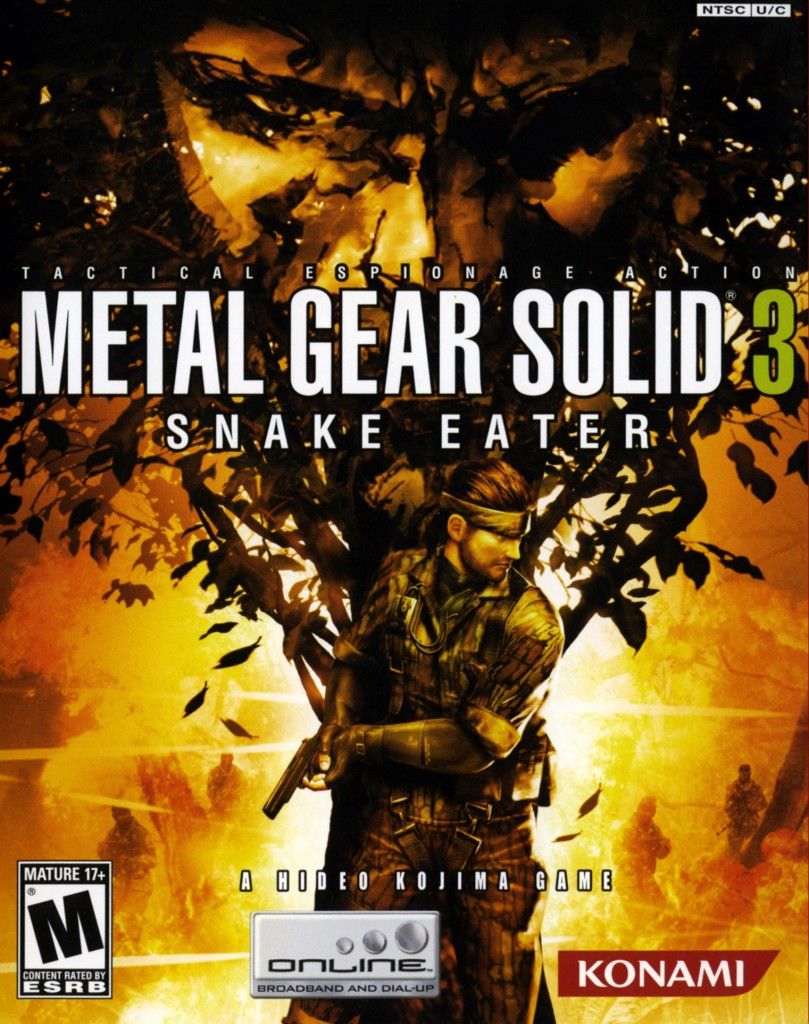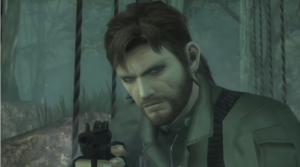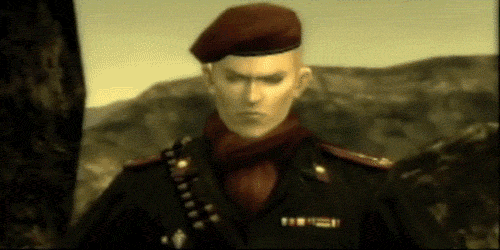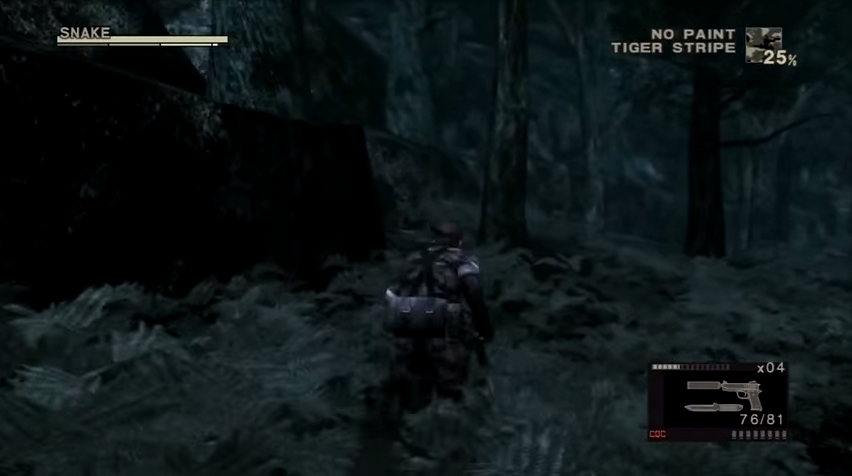The Metal Gear video game franchise has a reputation for excellence in storytelling and innovative gameplay. It is also comically difficult. Join Deadshirt Editor-in-Chief and absolutely terrible video gamer Dylan Roth as he plays through the entire Metal Gear canon in anticipation of the long-awaited Metal Gear Solid V: The Phantom Pain, out this fall.
If you’ve been reading SNAAAAAAAKE! from the beginning, then you know that besides the first Metal Gear Solid, I’ve never played any of the games in the Metal Gear series before. A lot of the fun of this column has been weighing my first impressions of the games against their longstanding reputations. From the outset, I’ve been aware of Metal Gear Solid 2: Sons of Liberty‘s reputation as the best game in the franchise, and was ready to accept that as I continued through the remaining six games in the series. Perhaps it was that expectation that made me completely unprepared for how much I would love Metal Gear Solid 3: Snake Eater, which I’m ready to declare the greatest video game I’ve ever played.
Snake Eater is a departure from the previous Metal Gear games in many respects, most notably its setting. While the first four games all take place in the near future (usually about five to ten years after they were released), Snake Eater is set in 1964, and centers not around Solid Snake but on his “father,” Big Boss, the man whose DNA was used to create Les Enfants Terrible. A stylish period piece, Snake Eater takes its cues from classic Cold War spy thrillers, including the James Bond series. Just look at (and more importantly, listen to) the opening credits sequence:
Snake Eater puts the player in control of a young soldier as he embarks on a violent and emotional mission to kill his mentor/surrogate mother and prevent World War III. Along the way, his ideals are thrown into question, his heart is broken, and his face is mutilated. Also, he has to eat a whole bunch of gross wild animals. Like all Metal Gear Solid games, it’s a weird and wild ride.
Originally released for the PlayStation 2 in late 2004, Metal Gear Solid 3 has received a number of re-releases: the cross-platform expanded edition MGS3: Subsistence in 2006, an HD remaster for PS3, XBox 360, and PS Vita in 2011, and a 3D version for the Nintendo 3DS in 2012. For this review, I used the HD copy in the Metal Gear Solid: Legacy Collection for PS3, which includes most of the features added for Subsistence.
Let’s go back in time to the golden age of espionage, and try not to cause any time paradoxes along the way.
Story
At the height of the Cold War, rugged soldier codenamed Naked Snake (voice of David Hayter) is air-dropped into a Soviet jungle landscape, tasked with smuggling a brilliant scientist, Dr. Solokov, back to the US. Snake ably sneaks into the enemy camp and nearly escapes with Solokov, but is stopped by someone he doesn’t expect: his old mentor, The Boss, the legendary soldier who basically raised him. The Boss, it seems, has defected to the USSR, and nearly kills Snake to keep Solokov under the control of rising USSR leader Leonard Brezhnev’s forces. The Boss even delivers a new shoulder-mounted nuclear launcher to her new comrade, the treacherous Colonel Volgin, who proceeds to fire a nuke into his own territory to cover his tracks.
The incident throws US-Soviet relations into turmoil. Soviet First Secretary Khrushchev, control of his country already slipping from his grasp, demands that US President Johnson deploy a secret mission to kill The Boss and prove that America had no involvement in the nuclear incident. The Boss may be the best fighter alive, so the US sends the next best thing: her protégé, Snake.
Snake struggles to survive in the harsh jungle conditions demanded by the mission, subsisting on local flora and fauna, particularly a wide variety of deadly and delicious snakes. He faces off against each member of The Boss’s loyal compatriots, The E Street Band the Cobras: The Pain, who controls a swarm of hornets; The Fear, who leaps invisibly from tree to tree; The Fury, an ex-cosmonaut and current pyromaniac; and The End, an impossibly old sniper with a unique rapport with nature. He’s confronted by the sadistic Colonel Volgin, a mutant who can store and direct lethal doses of electricity, and the Shagohod, a monstrous super-tank developed by Sokolov that has freaking rocket engines attached to it. But the greatest trial Snake must face is the knowledge that, even if he survives all of this, nothing will be as difficult as putting a bullet in The Boss’s head.
SPOILERS AHEAD
After the mind-bending fuckery that was Sons of Liberty, Snake Eater presents a comparably straight-forward plot (y’know, for a spy story). There are certainly double-crosses and secret agendas, but nearly all the major betrayals are revealed in the final cutscenes, after the playable portion of the game is over. The big picture of the story is fairly simple, but the characters are a lot more complicated and fleshed out, which makes it a much more fulfilling adventure than any of its predecessors.
Naked Snake is immediately a more human and relatable character than any of his sons, which is beautifully ironic seeing as he’s the villain of the first two Metal Gear games. That Snake’s mission is more personal here than in any previous Metal Gear adventure gives him a lot of texture. He’s been assigned to kill the only family he has—the woman who made him who he is, probably the only person he loves—in order to avert nuclear holocaust, and the way he goes about it highlights his values, sense of honor, and surprisingly, his intimacy issues.
The Boss is a fascinating character who gets more awesome and intriguing the more is revealed about her: she’s “the mother of special forces,” inventor of the CQC (close-quarters combat) fighting method, and secretly the first American in space. Her defection to the USSR, it’s eventually revealed, is actually ordered by the CIA as part of a deep cover operation, but when Volgin’s nuclear outburst changes the parameters of her mission, she must sacrifice her life to complete her mission and save the world, even though it means being remembered as a traitor and mass-murderer. This is a woman so badass that she stormed the beaches of Normandy on D-Day, where she then proceeded to give birth. If Snake Eater were adapted into a movie today, she’d have to be played by Robin Wright, because no other human being alive possesses the right combination of gravitas and statuesque beauty.
It’s noteworthy that The Boss is that rare female character in an action-adventure game who’s rarely sexualized, even though she may have a sexual history with the protagonist. She is, of course, built like Wonder Woman, and feels compelled to conduct the final boss fight with her spacesuit unzipped to her navel, but the context of the scene sort of forgives the weird show of skin.
Speaking of impractically unzipped jumpsuits, let’s talk about EVA, the sexy spy who steals Snake’s heart. EVA is a KGB agent (but not really) who defected from America (but actually didn’t) and is now assigned to assist Snake in killing The Boss and stopping Volgin from reeking havoc with the Shagohod tank (except her real mission is something completely different and she actually works for the Chinese). EVA is a kickass secret agent with insane motorcycle skills and an outfit that would make Catwoman blush. Where The Boss’s sexuality is mercifully understated, EVA’s is Very Very Stated, the kind of weaponized sexuality typical in Bond Girls and femmes fatale and comes with a whole host of squicky connotations. She throws herself at Snake time and time again, and it’s only Snake’s confused and repressed desires (he’s here to kill his Jocasta figure, after all) that keep them from hooking up until after the mission is over. While her advances are initially intended to distract him from her true purpose, eventually EVA and Snake legitimately develop feelings for one another, and it’s only then that they finally hook up.
Snake Eater also introduces us to a young Revolver Ocelot, who at this point in his life is a young officer and shitty anime prince. After being bested by Snake at their first encounter, Ocelot becomes obsessed with killing him, before finally deciding that he’s too much fun to kill and that they’d rather be frenemies. Ocelot is an irredeemable shitbag in the contemporary-era Metal Gear Solid stories, but here he’s kind of pathetic, even a little adorable. Regard this ridiculous GIF of him summoning his Ocelot squad with a cat noise:
Snake Eater is an ideal prequel, telling a compelling, standalone story while shedding light on the existing games set decades later and setting up elements for Solid Snake’s grand finale in Metal Gear Solid 4. We see how Big Boss begins his journey from honorable soldier to mad warlord (which is further explored in four later games), we learn the origins of the villainous Patriots, and witness the beginnings of the Metal Gear weapons program. It takes the best stylistic elements of its predecessors while also feeling like entirely its own animal. It’s a goddamn masterpiece, and its excellence doesn’t end with the storytelling…
Gameplay
Snake Eater was originally intended for release on the PlayStation 3, and it shows: it adds a ton of new features to the series’ tried-and-true blend of sneaking around and blowing things up. The most prominent addition is the camouflage system, in which your visibility to enemies isn’t based solely on proximity but on how well you blend into your environment. You’re given the ability to change your uniform and paint your face on demand to better disappear into shrubs, grass, sand, brick walls, or whatever else your environment offers you. This takes the series’ stealth gameplay to a whole new level, and once you get good at it it’s incredibly satisfying. It also encourages the player to be more patient, rather than rushing through. For the first time, it’s actually possible to complete the game without being seen by any guards or sentries, never entering Alert Mode at all. (Needless to say, I did not accomplish this goal.)

The Survival Viewer, which allows you to change camouflage and treat injuries, is a welcome addition to the series’ gameplay.
Snake Eater also takes what could be considered a disadvantage—the inability to science fiction-away problems with futuristic technology—and turns it into the game’s greatest strength. Unlike Solid Snake, Naked Snake doesn’t have an army of nanomachines running through his veins, healing his wounds and repressing inconvenient bodily functions. This Snake needs to eat, rest, and and treat his wounds to survive. Rather than simply taking life-restoring rations like in the previous four games, Snake must now consume food to restore a stamina bar, and allow time to regain his health. The player is also responsible for stitching up cuts, fishing bullets out of gunshot wounds, and counteracting local toxins. If you don’t eat or don’t tend to your injuries, your health bar won’t restore all the way and your ability to move and fight will be limited.
Though not included in the original release of the game, Subsistence and all subsequent versions include an attached, movable third-person camera, removing the series’ biggest gameplay hurdle. The fixed camera system from the first two Solid games is still available for purists, but players like me who found this frustrating no longer need to suffer through it. Sneaking and combat have never been easier (mechanically speaking, anyway), and despite being a late addition to the game, the new camera feels entirely natural to the play experience (unlike, for example, the addition of first-person shooting in The Twin Snakes).
I played Snake Eater on Easy Mode, and I found it reasonably challenging and rarely frustrating. This is the first game I’ve ever played where I felt like I could immediately begin again at a higher difficulty level. I had to resist the urge, however, because I’ve still got a ton of Metal Gear left to play and review! Join me next week for Metal Gear Solid 4: Guns of the Patriots.
NOTE: Metal Gear Solid V: The Phantom Pain is receiving incredible advance reviews, and will be released next Tuesday, September 1st. You’re gonna want to pre-order this thing immediately.
NOTE 2: I haven’t forgotten about Portable Ops; I’ll be folding that into my Peace Walker review in Part 7.







